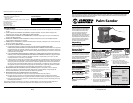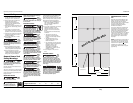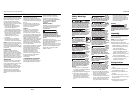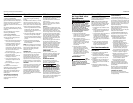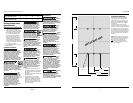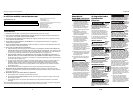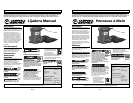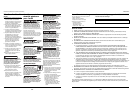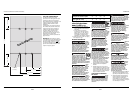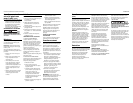
17 Sp
DG480100CK
Información General
de Seguridad sobre
Herramientas
Eléctricas (Continuación)
Use la
herramienta eléctrica, sus accesorios
yUse la brocas etc. de acuerdo con
estas instrucciones, tomando en cuenta
las condiciones de trabajo y el trabajo
que desea hacer. El uso de una
herramienta eléctrica para trabajos
diferentes de aquellos para los cuales
ha sido diseñada, puede resultar en
una situación peligrosa.
1. Esta herramienta NO debe
modificarse ni usarse para cualquier
aplicación que no sea la aplicación
para la cual fue diseñada.
2. Use solamente accesorios
recomendados por el fabricante de
su modelo. Los accesorios
apropiados para una herramienta
pueden causar un riesgo de lesión
cuando se usan con otra
herramienta.
3. Algunas maderas contienen
conservadores que pueden ser
tóxicos. Tenga especial cuidado
para evitar la inhalación y el
contacto con la piel con estos
materiales. Solicite y cumpla con
toda la información de seguridad
disponible por parte de su
proveedor de materiales.
MANTENIMIENTO
Haga
que sólo
personal calificado preste
mantenimiento a su herramienta
eléctrica y usando sólo repuestos
idénticos. Esto asegura que se preserva
la seguridad de la herramienta
eléctrica.
Ensamblaje
Asegúrese de que la herramienta no
esté conectada a una fuente de
corriente, luego coloque la herramienta
dada vuelta sobre el banco.
NOTA: utilice sólo almohadillas para
lijar del mismo tipo, tamaño y peso.
Siga estos pasos para conectar la bolsa
de recolección de polvo al orificio de
salida del polvo de la lijadora:
a. Asegúrese de que la bolsa no esté
al revés.
b.Deslice la bolsa de recolección por
la manguera de la aspiradora con
el soporte de la bolsa.
c. Tire del elástico de la bolsa hacia la
manguera de la aspiradora.
Asegúrese de que el elástico esté
colocado en la muesca de plástico.
Esto asegura un calce más justo y
un menor riesgo de que la bolsa se
resbale.
d.Sujete el conjunto de la bolsa al
orificio de salida del polvo de la
lijadora, insertándolo hasta que
llegue al fondo del orificio.
Pre-Funcionamiento
ANTES DE ENCENDER LA
HERRAMIENTA:
1.Use siempre protectores auditivos
y máscara contra el polvo.
2.Use gafas de seguridad, en especial
cuando lije por encima de su cabeza.
3.La lijadora no es apta para lijar en
húmedo.
4.Asegúrese de que el interruptor de
encendido no esté en la posición
“ON” antes de enchufar el cable de
corriente.
5.Mantenga el cable de corriente
alejado de las piezas móviles de las
herramientas.
TENGA EN CUENTA ANTES DEL
FUNCIONAMIENTO:
1.ELECCIÓN DEL PAPEL DE LIJA
El papel de lija grueso (grano 60) quita
el material en general y el papel de lija
fino se usa para las terminaciones. Si la
superficie no está pareja, comience con
papel de lija grueso y lije hasta que la
superficie esté pareja.
Utilice papel de lija mediano (grano
100) para quitar los rayones que dejó
el papel de lija grueso.
Use papel de lija fino (grano 150) para
alisar y dar la terminación.
2.INSTALACIÓN DEL PAPEL DE LIJA.
Asegúrese de que el papel de lija sea
del tamaño y tipo correctos para la
almohadilla de lijado a usar.
a.Desenchufe la herramienta.
b.Abra la abrazadera trasera
levantando el extremo de la
abrazadera del papel.
c. Instale el papel de lija bajo la
abrazadera. Asegúrese de que el
papel quede centrado en la
almohadilla. Las perforaciones en
el papel deben corresponderse
con las de la base, para que el
polvo pueda salir correctamente.
d.Coloque el resorte de sujeción de
nuevo en su posición original.
e.Repita la operación para fijar el
papel de lija en el frente.
f. Verifique que las perforaciones en
el papel de lija se correspondan
con los orificios de salida.
g.Fije el papel de lija lo más
ajustado que sea posible.
Quite el recubrimiento de la parte
trasera del papel de lija (si usa papel
recubierto con adhesivo sensible a la
presión [PSA]).
Alinee el papel con la almohadilla de
lijado y luego presione con firmeza
toda la superficie de la almohadilla.
ASPIRADO DEL POLVO
La bolsa de recolección del polvo
recoge el polvo a través de los orificios
en el papel de lija.
4
www.chpower.com
Pre-Operation (Cont’d.)
CONSIDER BEFORE OPERATING:
1.CHOICE OF SANDPAPER
Coarse sandpaper (grain 60) removes
general material and fine sandpaper is
used for the finishing. If the surface is
not even, then start with coarse
sandpaper and sand until the surface is
even.
Use medium sandpaper (grain 100) to
remove scratches left behind by coarse
sandpaper.
Use fine sandpaper (grain 150) for
smoothing and finishing.
2.INSTALLING SANDPAPER.
Ensure sandpaper is the correct size
and type for the sanding pad used.
a.Unplug the tool.
b.Open the back clamp by lifting up
on the end of the paper clamp.
c. Install the sandpaper under the
clamp. Make sure the paper is
centered on the pad. The
perforations in the paper have to
correspond with those on the sand
sole, so that the dust can be
exhausted correctly.
d.Put the clamping spring back into
the original position.
e.Repeat the operation to fix the
sandpaper in the front.
f. Check the perforations in the
sandpaper correspond with the
exhaust gaps.
g.Fix the sand-paper as tight as
possible.
Peel release liner from back of
sandpaper (if using pressure sensitive
adhesive (PSA) backed paper).
Align paper over sanding pad then
press firmly over entire surface of
sanding pad.
VACUUM DUST COLLECTION
The dust collection bag picks up
sawdust through holes in the
sandpaper.
Operation
Palm sanders are designed so the palm
of one hand can guide tool during
sanding.
For additional dust collection, a central
vacuum or stand alone vacuum unit
may be connected to the sander’s dust
port in place of the dust collection bag.
1. Begin sanding process by selecting
the finest grit suitable for the initial
sanding pass. The grit should be
coarse enough to remove burrs and
excessive roughness.
2. Once the initial sanding noted above
is complete, change the sandpaper
by one grit range (example: coarse to
medium), and continue the finishing
process.
3. Continue process by changing to
successively finer grits until desired
finish is obtained.
NOTE: Do not change from coarse grit
to very fine grit sandpaper in one step.
Swirl marks that might have been
made with the coarse grit will be
difficult to remove.
SANDING FLAT
The sand sole of your sanding machine,
executes small circular movements.
Through this you will get an even
surface without marks. Since a circular
movement is executed, it is not very
important how to hold and move your
sanding machine. It is rarely necessary
to bring extra pressure to the machine.
FINISHING
Inspect the surface to be finished. If its
coat is cracked or peeling, then first
remove as much as possible with a
brush or scraper. Then use coarse
enough sandpaper to remove the
remaining coating. Sand the surface
flat, eliminating all spots and thusly
preparing the surface for a new coat of
paint or varnish.
Maintenance
Tool service must be performed only
by qualified repair personnel. Service
or maintenance performed by
unqualified personnel could result in
a risk of injury.
If the tool does not start or operate
properly, return the tool to a service
facility for repairs.
Cleaning
Clean out dust and debris from vents
and electrical contacts by blowing with
compressed air. Motor vents and
switch levers must be kept clean and
free of foreign matter. Do not attempt
to clean by inserting pointed objects
through openings. Keep tool handles
clean, dry and free of oil or grease.
Use only mild soap and a damp cloth
to clean the tool, keeping away from
all electrical contacts.
Certain cleaning agents and solvents
are harmful to plastics and other
insulated parts. Some of these include
gasoline, turpentine, lacquer thinner,
paint thinner, chlorinated cleaning
solvents, ammonia and household
detergents containing ammonia.
Never use flammable or combustible
solvents around tools.
LUBRICATION
For your continued safety and
electrical protection, lubrication and
service on this tool should ONLY be
performed by an AUTHORIZED
CAMPBELL HAUSFELD SERVICE
CENTER.
TECHNICAL SERVICE
For information regarding the
operation or repair of this product,
please call 1-800-424-8936.
Tool
service
must be performed only by qualified
repair personnel. Service or mainte-
nance performed by unqualified per-
sonnel could result in a risk of injury.
When servicing a tool, use only
identical replacement parts. Follow
instructions in the Maintenance section
of this manual. Use of unauthorized
parts or failure to follow Maintenance
instructions may create a risk of
electrical shock or injury.
Operating Instructions and Parts Manual



